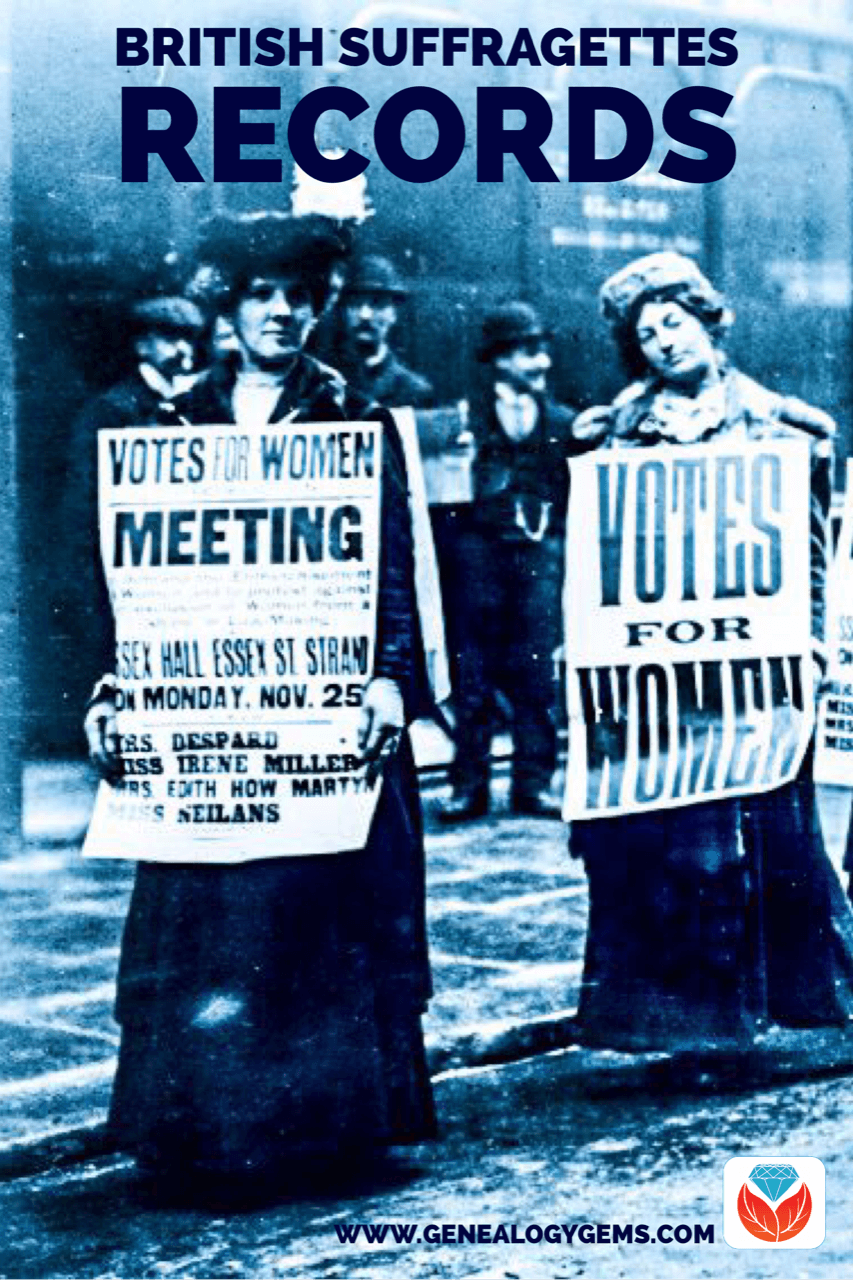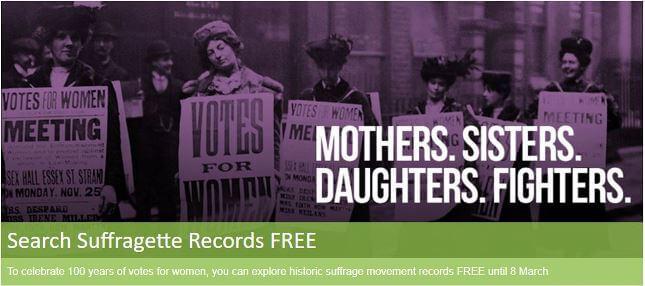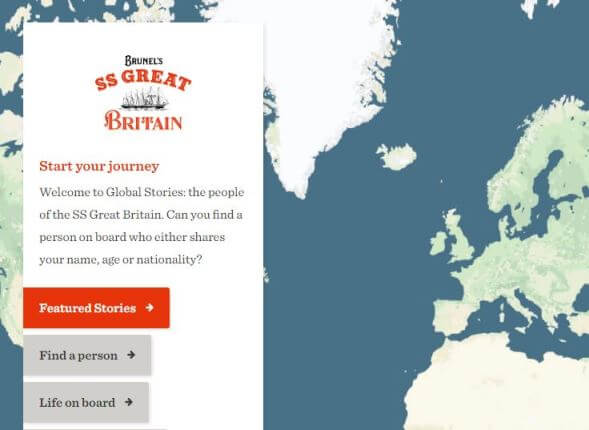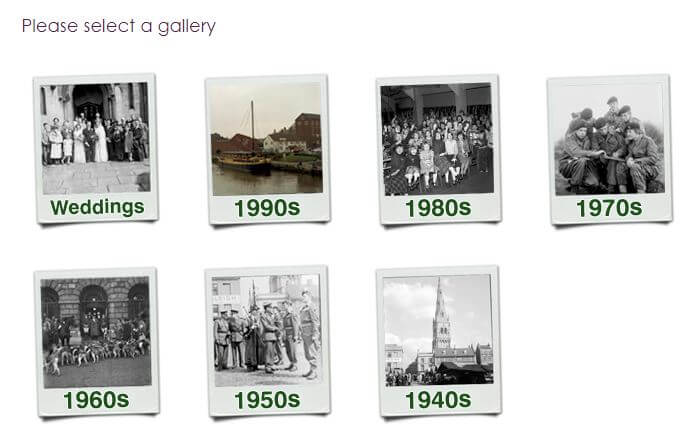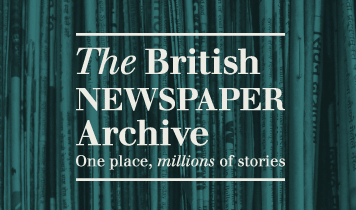Blog

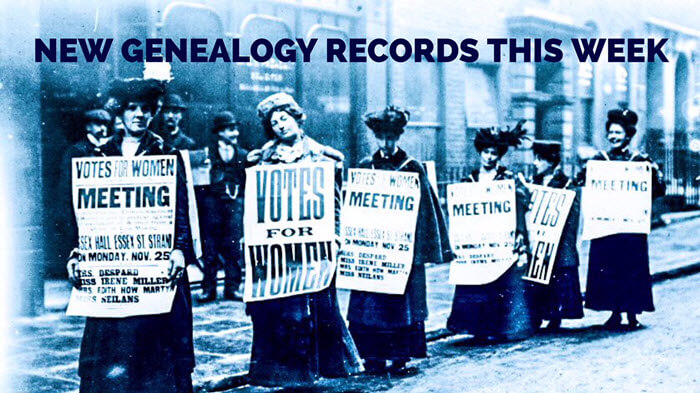
New Genealogy Records Include UK Suffragettes and Travelers’ Records
New collections about Great Britain Suffragettes and travelers on the S.S. Great Britain headline this week’s roundup of new genealogy records online. Read here about more new genealogy records for England, Scotland and Ireland: parish records, newspapers and more.
Great Britain Suffragettes Collection free until March 8
In honor of the 100th anniversary of the first phase of women’s suffrage in England, genealogy giant Findmypast.com (together with The National Archives) has launched The Suffragette Collection. This new online collection of government records, digitized from originals at Kew, “reveals the struggles endured by the movement’s most ardent supporters and highlights the State’s response as it attempted to contain them,” says a company press release.
“Researchers can expect to find photographs, cabinet office papers, calendars of prisoners and Home Office papers on suffragette disturbances and prosecutions,” says Findmypast. “The collection also includes an index of women arrested between 1906 and 1914, the official police watch list recording the details of over 1,300 militant suffragettes, reports of prison conditions, force-feeding, police surveillance and much more….The collection brings together the stories of women from all classes who actively supported women’s suffrage, either by attending demonstrations and meetings or opting for militant ‘direct action.’”
Within days of its launch, the collection also added 271 issues of The Suffragette (later The Britannia, 1912-1918). “Edited by Christabel Pankhurst, it was the official organ of the Women’s Social and Political Union (WSPU),” says Findmypast. It reported on “efforts made by the WSPU towards achieving women’s suffrage and detailing their support for the Allies during the Great War.”
S.S. Great Britain travelers and crew
You can now explore a free website with a searchable database of everyone who ever traveled on the S.S. Great Britain, both passengers and crew. Virtual exhibits on the Global Stories website also allow visitors to explore everyday life aboard the ship; what happened when people died, took ill, were hurt, or gave birth; what kinds of entertainment or discipline passengers could expect and more. You can even search departures and arrivals as the ship circumnavigated the globe 32 times and stopped at five continents between 1845 and 1970.
The Newark Advertiser Photo Archive
Thousands of images from The Newark Advertiser (UK) are now searchable online, thanks to volunteers who have been steadily digitizing and uploading images to the free Images from the Past gallery. According to a recent article in The Newark Advertiser, helpers “are working their way through thousands of old photographic negatives, some dating back to the 1940s. Because of their age, some of the negatives are becoming damaged or corroded so it is vital that they are digitized. They are also in a variety of formats, with the earliest on glass. The volunteers have worked through from the 1940s and are now nearing the 1970s.”
Newspapers
The British Newspaper Archive has recently added hundreds of thousands of digitized newspaper pages to current and newly-published titles. Here are some highlights:
- North Star and Farmer’s Chronicle, 1895-1903 and 1905-1911 (NEW title)
- Clifton Society, 1891-1892, 1894-1897, 1899-1916 (nearly 20,000 pages added) (NEW title)
- Ally Sloper’s Half Holiday, 1885-1896 (NEW title)
- Pearson’s Weekly, 1891-1911 (over 25,000 pages added) (NEW title)
- Birmingham Daily Post, 1973, 1979 (nearly 15,000 pages added)
- Neots Chronicle and Advertiser, 1855-1873, 1875-1886
- Shipping and Mercantile Gazette, 1880-1881
- Birmingham Daily Gazette, 1926, 1931
- Lloyd’s List, 1889, 1894, 1896-1897, 1904, 1906-1909 (nearly 40,000 pages added!)
- Northampton Chronicle and Echo, 1880-1882, 1884-1885, 1891, 1893-1894, 1896, 1899-1908, 1910, 1913-1915, 1918 (nearly 25,000 pages added)
- Bristol Daily Post, 1860-1864, 1867-1873, 1875 (nearly 14,000 pages added) (NEW title)
- Clifton and Redland Free Press, 1890-1895, 1898-1910, 1913-1931 (NEW title)
- West Middlesex Herald, 1855-1858, 1860-1861, 1863-1870, 1890-1895 (NEW title)
- Reading Observer, 1897-1898, 1900-1909, 1911-1914, 1921-1924 (over 12,000 pages added)
- Kinross-shire Advertiser, 1850-1852, 1879-1884, 1890, 1892, 1900-1918
- Leicester Herald, 1827-1842 (NEW title)
- The Suffragette, 1912-1918 (NEW title)
- Coventry Evening Telegraph, 1972-1979 (over 140,000 pages added!)
- West Sussex County Times, 1874, 1877-1889, 1891-1892
- Bristol Magpie, 1891, 1903, 1906-1907, 1911
- Horfield and Bishopston Record and Montepelier & District Free Press, 1899-1911, 1913-1931
- Middlesex & Surrey Express, 1887-1888, 1890-1895, 1899-1909 (over 11,000 pages added)
- Croydon Chronicle and East Surrey Advertiser, 1870, 1875-1888, 1890-1892, 1894-1896, 1898-1908, 1911 (more than 14,000 pages added)
- The Clifton & Redland Free Press, 1891-1931
England parish and probate records
The free genealogy giant, FamilySearch.org, has recently added significantly to its collections of England parish records:
- England, Derbyshire, Church of England Parish Registers, 1537-1918: Well over half a million indexed names have been added
- England, Warwickshire, Parish Registers, 1535-1984: More than 1.1 million indexed names have been added
- England, Rutland Parish Registers, 1538-1991: A new collection with over 325,000 indexed names
The subscription-access genealogy giant Ancestry.com recently published the following collections:
- Buckinghamshire, England, Extracted Church of England Parish Records, 1535-1812, a new collection with about 65,000 records.
- Wiltshire, England, Wills and Probate, 1530-1858, a new collection of over 100,000 records.
Findmypast.com has updated its collection of Devon parish records, with over 30,000 new records in Baptisms, nearly 40,000 new records in Banns and nearly 80,000 new records in Marriages, about 31,000 new records in Burials, and all of these records (and more) browsable in its image collection of Devon, Plymouth & West Devon Parish Registers.
More new genealogy records from the British Isles
Ireland. Ancestry.com has published a new collection, Clare, Ireland, Church of Ireland Baptisms, Marriages and Burials, 1744-1991, with nearly 14,000 indexed records. According to the collection description, “This collection includes baptism, marriage, and burial records from parishes in the County of Clare in Ireland, with dates ranging from 1744 to 1991.”
Scotland. Ancestry.com has published three new collections for Scotland. They are small, but if they mention your ancestors, they’re important!
Start tracing your British Isles genealogy
The British Empire once spanned the globe and had a presence on every continent. Chances are that at some point you will need to extend your research back to the British Isles. Genealogical research in the British Isles has some unique characteristics. Guest blogger Kate Eakman, a Senior Researcher for Legacy Tree Genealogists, clarifies confusing terms and helps you get your research started on solid footing. Click here to read her tips.

About the Author: Sunny Morton
Sunny is a Contributing Editor at Lisa Louise Cooke’s Genealogy Gems; her voice is often heard on the Genealogy Gems Podcast and Premium Podcasts. She’s known for her expertise on the world’s biggest family history websites (she’s the author of Genealogy Giants: Comparing the 4 Major Websites); writing personal and family histories (she also wrote Story of My Life: A Workbook for Preserving Your Legacy); and sharing her favorite reads for the Genealogy Gems Book Club.
Disclosure: This article contains affiliate links and Genealogy Gems will be compensated if you make a purchase after clicking on these links (at no additional cost to you). Thank you for supporting Genealogy Gems!

Inspiring Family History Video Ideas Sent In By YOU
These family history video ideas and comments/questions sent in by Genealogy Gems listeners can inspire your own short videos. See how they script their stories, find royalty-free music soundtracks and more. Then visualize yourself in the director’s chair—what kind of family history video do YOU want to make?
For a while now, I’ve been encouraging everyone to produce their own short family history videos. You don’t need a big budget, lots of fancy equipment or even a director’s chair (although I wouldn’t mind having one of those!). A few simple online tools, like Animoto’s do-it-yourself video platform, can help you create family history videos that are oh-so-shareable with relatives on social media. I’ve heard some great family history video ideas from you—along with an important question about finding royalty-free music.
Family history video ideas: Celebrate special birthdays
Muffy in Seattle, WA sent in the following email:
“Finally got around to listening to Episode #213 and the great story about the video y’all made to go with Tom’s poem [watch it below]. What a great idea to have him read his poem and then add pictures. Something to think about for my future videos!
This inspired me to share a video I created this past Christmas for my Dad. Trying to find out where our branch of Walkers comes from was my inspiration for starting into the very addicting world of genealogy. Unfortunately, it remains the only direct line I cannot trace across the pond. Gotta retire! Here is a link to my first video I wanted to share. Great hit with my Dad, uncle, and cousins. Maybe it will be inspiration for others to take the leap into the video world.”
Family history video question: What about music?
Melissa sent this important question about creating a soundtrack for your family history videos:
“Hello Lisa,
I have made a video using a basic subscription to Animoto and am very pleased with it. I do have a question about using music. While there are some choices on my basic subscription, I seem to have my own idea of the music I would like. In your video you mentioned to make sure the music we download is permissible.
I searched for public domain music and came up with nothing useful. Even looked on the Library of Congress Jukebox collection but it is only streamed and I think using that would not be permissible. How do I find more available and permissible music to use for the videos? My videos are just for family members and not for profit but I want to do the right thing.
I look forward to your podcasts and videos. You continue to educate me!”
Here are some tips for Melissa (and the rest of you) about finding music. First, I do use music that comes with two video-creating tools I use: Animoto (you can purchase personal subscription plans for 10% off with promocode PER10OFF) and Camtasia, which video software I use all the time (it’s a special favorite for screen-capturing my Google Earth Family History Tours).
Unfortunately, I have found free royalty-free music sites few and far between. You’re smart to be cautious because if you were to put your video on YouTube they have the technology to identify any song that is used that is a violation of copyright.
The good news is that YouTube does make free music available to you. Sign in to YouTube with your Google account, click on your picture in the upper right corner, and go to your Creator Studio. Upload your video (you can keep it private if you wish) and then on the video page click “Audio” (above the video title). There are many music tracks to choose from. Once you’ve added a track and saved it, you should be able to download the video with the music included.
An easy way to browse royalty-free music on YouTube is to filter your YouTube search results by those marked with a Creative Commons license, like this:
(Just be sure to read up on using Creative Commons material. There are still rules to follow about how to use it and how to properly credit it.)
Melissa sent this answer: “Thank you, Lisa, for your response. I did go to YouTube and found the music I wanted, “Keep on the Sunny Side,” with a Creative Commons license. My mother sang that when I was a child and she heard it from her aunt, who raised her when she was a child. It was the perfect song for the Animoto video of my mother’s memories of her mother and aunt. It was wonderful to find that song in public domain! I had no idea to look there before your response.”
Family history video ideas: Put your memories to music
Not long ago, I helped Genealogy Gems listener Tom Boyer put his own memories to music. He’d actually written his thoughts in poem form, inspired by the “Where I’m From” family history poetry initiative we shared with listeners in the free Genealogy Gems Podcast episode 185. It took Tom a while to write his own poem, but he finally sent it in. I found it so inspiring I created a video with his pictures and an audio track of him reading it. You can listen to the free Genealogy Gems Podcast episode 213, mentioned above, to hear more about how that collaboration with Tom went. Watch the video here–I think it turned out beautifully:
More family history video ideas
The Genealogy Gems website is packed with resources for helping you create beautiful family history videos and books for sharing your family history with loved ones. Try these ones:
6 tips to create family history books they can’t put down

About the Author: Lisa Louise Cooke
Lisa is the Producer and Host of the Genealogy Gems Podcast, an online genealogy audio show and app. She is the author of the books The Genealogist’s Google Toolbox, Mobile Genealogy, How to Find Your Family History in Newspapers, and the Google Earth for Genealogy video series, an international keynote speaker, and producer of the Family Tree Magazine Podcast.
Disclosure: This article contains affiliate links and Genealogy Gems will be compensated if you make a purchase after clicking on these links (at no additional cost to you). Thank you for supporting Genealogy Gems!
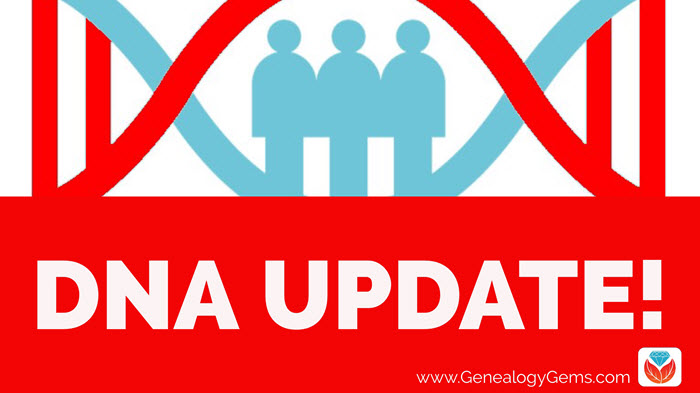
Genealogy Gems Podcast Episode 214
The Genealogy Gems Podcast Episode 214
with Lisa Louise Cooke
In this episode, Irish expert Donna Moughty joins host and producer Lisa Louise Cooke to talk about Irish genealogy to help you get a jump on yours before everyone starts talking about their Irish roots on St. Patrick’s Day next month! Also in this episode:
- Your DNA Guide Diahan Southard has DNA news
- Other listeners write in with inspiring successes
- Michael Strauss musters in with tips on finding your ancestors in the five branches of the U.S. military.
NEWS: MYHERITAGE DNA MATCHING UPDATE
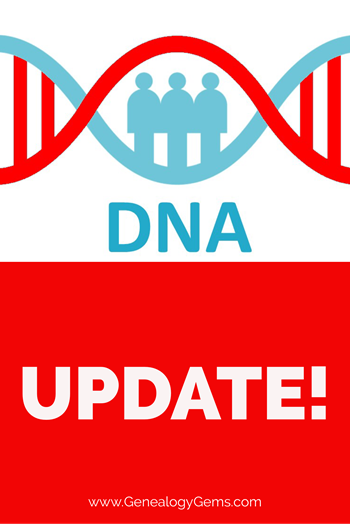
The MyHeritageDNA test matching algorithm has gotten better?AND they’ve added a chromosome browser. Time to test with MyHeritage DNA or upload your results from another company for free? Click here to read all about it!
MAILBOX: LISTENERS ON FAMILY HISTORY VIDEOS

Muffy in Seattle sent this link to her family history video. Great job!
Melissa asked about finding copyright-free music to add to family history videos. Lisa’s tips:
Unfortunately, free royalty-free music sites are few and far between.
You’re smart to be cautious because if you were to put your video on YouTube they have the technology to identify any song that is used that is a violation of copyright.
YouTube does make free music available:
- Sign into YouTube with your Google account
- Click on your picture in the upper right corner and go to your Creator Studio.
- Upload your video (you can keep it private if you wish) and then on the video page click “Audio” (above the video title).
- Choose among the many music tracks there.
- Once you’ve added a track and saved it, you should be able to download the video with the music included.
The other source of music I use is music that comes with the programs I use (Animoto and Camtasia).
GENEALOGY BUSINESS ALLIANCE
GBA Buzz game for RootsTech 2018; Play the game. See websites for complete rules.
Lisa Louise Cooke uses and recommends RootsMagic family history software. From within RootsMagic, you can search historical records on FamilySearch.org, Findmypast.com and MyHeritage.com.

Keep your family history research, photos, tree software files, videos and all other computer files safely backed up with Backblaze, the official cloud-based computer backup system for Lisa Louise Cooke’s Genealogy Gems. Learn more at https://www.backblaze.com/Lisa.
INTERVIEW: DONNA MOUGHTY ON IRISH RESEARCH
The following review appeared in the January 2018 newsletter of the Midwest Genealogy Center, Mid-Continent Public Library:
“If you want a quick guide on how to get started on Irish research, this short, four-page guide is an excellent resource. This guide will help you start your research in the United States, so you can figure out where in Ireland your ancestor came from. It is organized into 12 steps with helpful websites added. This guide is the first in the Irish Research Series by Donna M Moughty.”
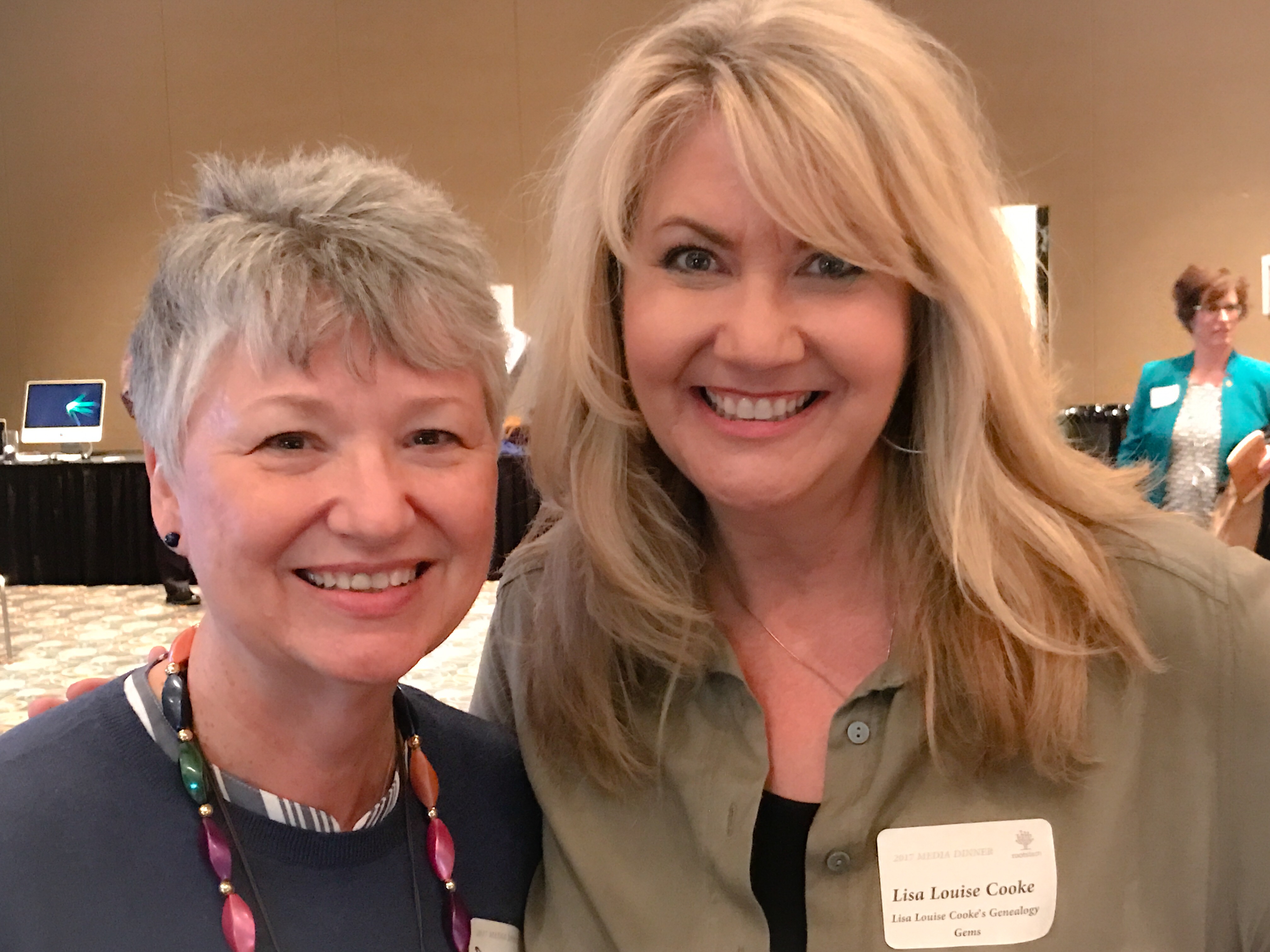
Donna Moughty, shown left with Lisa Louise Cooke, is a professional genealogist and former Regional Manager for Apple Computers. She has been conducting family research for over 20 years. She teaches classes for beginners and lectures on a variety of subjects including Internet, Irish research, and computer topics. In addition, she provides consultations, research assistance, and training. She is a member of Association of Professional Genealogists and the Genealogical Speakers Guild.
Websites mentioned in their conversation:
Donna’s Irish guide series – Discontinued
Preparing for Success in Irish Records Research – Guide #1 (reviewed above): Without the right preparation, researching in Ireland can be frustrating! Before you jump the pond, start your research at home to determine a place in Ireland, as well as details to help differentiate your person from someone of the same name. This research guide will walk you through the process of identifying records in the US to set you up for success in your Irish research.
Irish Civil Registration and Church Records – Guide #2. Civil Registration for all of Ireland began in 1864, with Protestant marriages dating back to 1845. Even if your ancestors left before that date, they likely had relatives that remained in Ireland. Prior to Civil Registration, the only records of births (baptisms), marriages or deaths (burials) are in church records. This Reference Guide will explain how to use the new online Civil Registration records as well as how to identify the surviving church records for your ancestors in Ireland.
Land, Tax, and Estate Records – Guide #3 (NEW!). Had the Irish census records for the 19th century survived, Griffith’s Valuation, a tax list, would not be one of the most important resources for Irish researchers. Without any context, however, it can just seem like a list that includes lots of people of the same name. This Guide explains how and why Griffith’s Valuation was done, and how to use it to glean the most information about your family. Once you know your ancestor’s locality in Ireland, Griffith’s Valuation can place them on a specific piece of land between 1846 and 1864. After Griffith’s Valuation, the Revision Books allow you to follow the land and in some cases, to the 1970s, possibly identifying cousins still living on the land.

Start creating fabulous, irresistible videos about your family history with Animoto.com. You don’t need special video-editing skills: just drag and drop your photos and videos, pick a layout and music, add a little text and voila! You’ve got an awesome video! Try this out for yourself at Animoto.com.

MyHeritage.com is the place to make connections with relatives overseas, particularly with those who may still live in your ancestral homeland. Visit www.MyHeritage.com
MyHeritage.com is the place to make connections with relatives overseas, particularly with those who may still live in your ancestral homeland. Click here to see what MyHeritage can do for you: it’s free to get started.
MILITARY MINUTES: 5 BRANCHES OF THE MILITARY

Each of the military branches is listed below, detailing information about when each was organized and resources available to genealogists on your ancestors who served in any of these branches.
United States Army. The largest of the five military branches dates back to June 14, 1775, during the early days of the Revolutionary War. Prior to the formation of the Army, each colony had companies and battalions of Associators and local militia. With the war, the need for a professional standing army to fight the British saw the formation of the Continental Army.
With the end of the Revolutionary War, the Army disbanded in 1783 after the signing of the Treaty of Paris. Later in 1796, two legions formed under the command of General Anthony Wayne would later become the nucleus of the United States Army. The Encyclopedia Britannica published this nice article on the history of the Army from its inception to the present.
A number of excellent genealogical resources are available to search for ancestors who served in the United States Army since the beginning. These databases are found on Ancestry, Fold3, and Family Search. One of the largest collections of records covers the United States Regular Army enlistments from 1798 to 1914 (available by subscription at Ancestry.com). Searching the card catalogs of Ancestry.com, Fold3 and FamilySearch will yield many databases that contain information about soldiers who served, and sacrificed their lives with the Army over the last two centuries.
United States Navy. The United States Navy dates from October 13, 1775 when it was officially established by an Act passed by the Continental Congress. At the end of the Revolutionary War it was disbanded, and again reestablished under the Naval Act of 1794 which created the Navy as a permanent branch of the military.
The history of the Navy and technology can be divided into two major eras. The earlier period, called the “Old Navy,” was the age of wooden sailing ships, and still later came the birth of the ironclads during the Civil War. The later period called the “New Navy” occurred with further innovations in late nineteenth century as the United States transformed into a global power recognized the throughout the world.
The United States Navy website has a nice background history of the service. Numerous databases and searches for records of the Navy covering multiple war period detailing pensions, continental sailors, muster rolls, ships logs, and cruise books are located on Ancestry.com, Fold3 and FamilySearch. Consult each database individually for records of interest.
Another organization related to the Navy is the United States Merchant Marines. Although not officially a branch of the military, the Merchant Marines sacrificed and lost lives since the days of the Revolutionary War, carrying out their missions of supply and logistics during times of war. Here’s an excellent website on the history of the Merchant Marines.
United States Air Force. The modern day Air Force dates from September 18, 1947, when it was formed as part of the Security Act of 1947. The Air Force and aviation history began under the authority of the United States Army, starting on August 1, 1907 when it was organized under the name of the Aeronautical Division of the Signal Corps. Over the next 30 years the service changed names several times:
- Aviation Section of the Signal Corps (1914-1918);
- Division of Military Aeronautics (1918);
- Air Service of the United States Army (1918-1926);
- United States Army Air Corps (1926-1941);
- United States Army Air Forces (1941-1947).
In that final year, it was separated as its own organization as it is known today. Click here for a complete history of the Air Force from 1907 to the present.
Two excellent online sources covering the early history of the Air Force from World War I and World War II are located on Fold3:
- Gorrell’s history when part of the AEF in 1917-1918 and
- Missing air crew reports during the World War II
United States Marines. This elite branch of the military began with the organization of the Continental Marines on November 19, 1775. The mission of the Marines initially comprised ship-to-ship fighting, security onboard naval vessels, and assistance in landing force operations. This mission would continue to evolve over the years. At the end of the Revolutionary War, the Marines were disbanded on October 4, 1783.
Along with the Navy, under the Naval Act of 1794, the United States Marines were again re-established and would serve faithfully in every major war period and in peacetime between conflicts. The Marines will forever remain true to their motto of “Semper Fidelis” or Always Faithful as they continue to live up to their long-running tradition of honor and service. Click here to watch an interesting and accurate history of the Marine Corps is viewable online on You Tube.
Ancestry.com has an excellent online genealogical resource for discovering Marine Corps ancestors: fully searchable Marine Corps muster rolls from 1798 to 1958 for enlistees.
Coast Guard. The history of this seagoing service dates back to August 4, 1790. Established as the Revenue Cutter Marines under the direction of Alexander Hamilton, the name was changed in 1894 to the Revenue Cutter Service until 1915. That year, an Act of Congress was passed and signed into law by President Woodrow Wilson called the “Act to Create Coast Guard.” The United States Live Saving Service and Revenue Cutter Service came together. Later, in 1939, the United States Light House Service was added to form the modern day United States Coast Guard.
The complete history of the United States Coast Guard from 1790 is on the Historians Office. It includes information about each of the separate organizations that came together to form the Coast Guard at. Ancestry.com has a collection of casualties of the Navy, Marines, and Coast Guard. Very few additional online sources are available online for this branch of the service. Researchers must access these documents and records onsite at the National Archives in Washington, DC.
Military Minutes Case Study
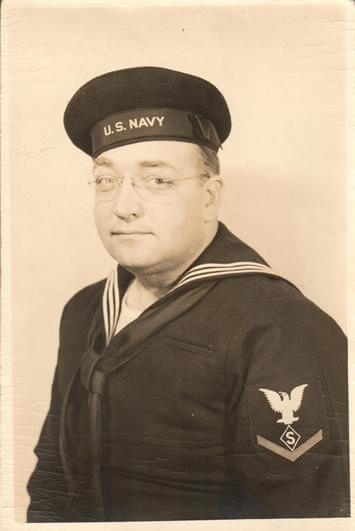
By Michael Strauss
Subject: Russell Strauss
Died: December 27, 1981-Jonestown, PA
Son of Harry B. Strauss & Agnes S. (Gerhart) Strauss
Over the last 30 plus years doing genealogy research, I’ve discovered that nearly all of my family members who served in the military were in the United States Army. But I have been occasionally surprised to find relatives who served in other branches of the military.
On the paternal family several years ago one of my cousins gave me a box of photographs. One of the images was marked Russell G. Strauss. He wore the uniform of the United States Navy during World War II. I recognized his name and knew that he was my grandfather’s first cousin. I was 16 years old when he died and didn’t know him very well.
His uniform indicated that he was a third class petty officer in the Navy during the war. I looked further at his uniform and noticed a diamond shaped “S” as part of the insignia. This military occupation indicated that he was a specialist that would require further research. I spoke with a couple of my older family members who knew Russell. All of my family interviewed said that he in the military police (M.P.) during the war. With additional research, I discovered that his insignia was that of the Shore Patrol. When I compared what my family said to me and his uniform told me the information matched very closely.
I found on Ancestry his application for compensation from the Commonwealth of Pennsylvania in 1950 when he served in the Shore Patrol in Norfolk, Virginia as part of his military duty (inserted below). Putting information from his photograph together with what my family members shared with me helped answer questions I had regarding of my relatives.
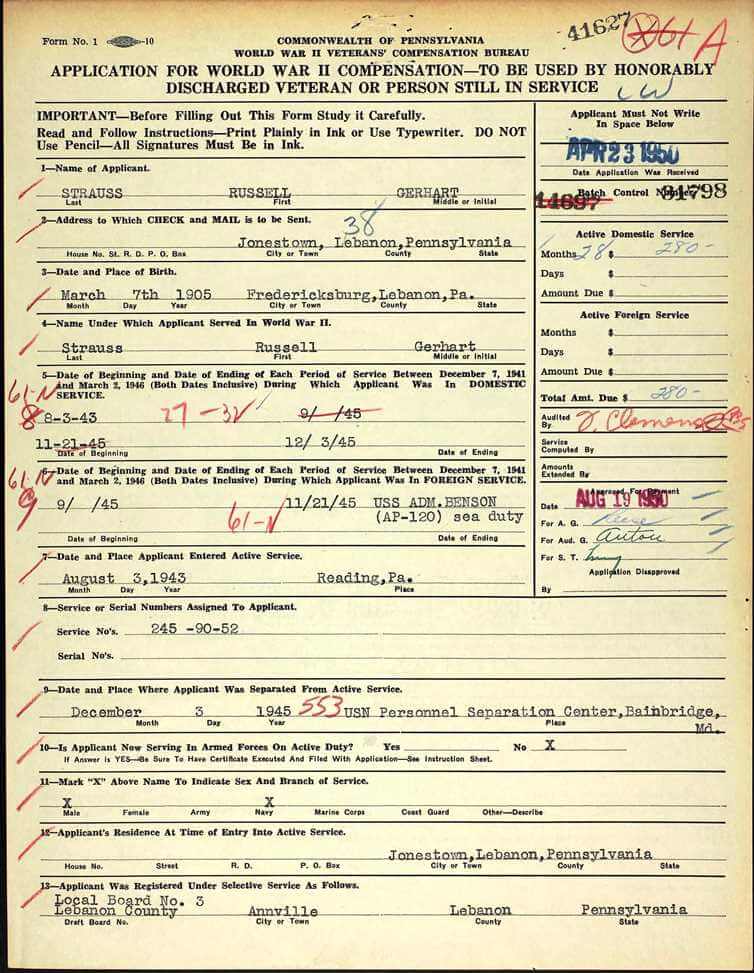

PRODUCTION CREDITS
Lisa Louise Cooke, Host and Producer
Sunny Morton, Editor
Vienna Thomas, Associate Producer
Hannah Fullerton, Production Assistant
Lacey Cooke, Service Manager
Disclosure: This page contains affiliate links and Genealogy Gems will be compensated if you make a purchase after clicking on these links (at no additional cost to you). Thank you for supporting this free podcast and blog!

